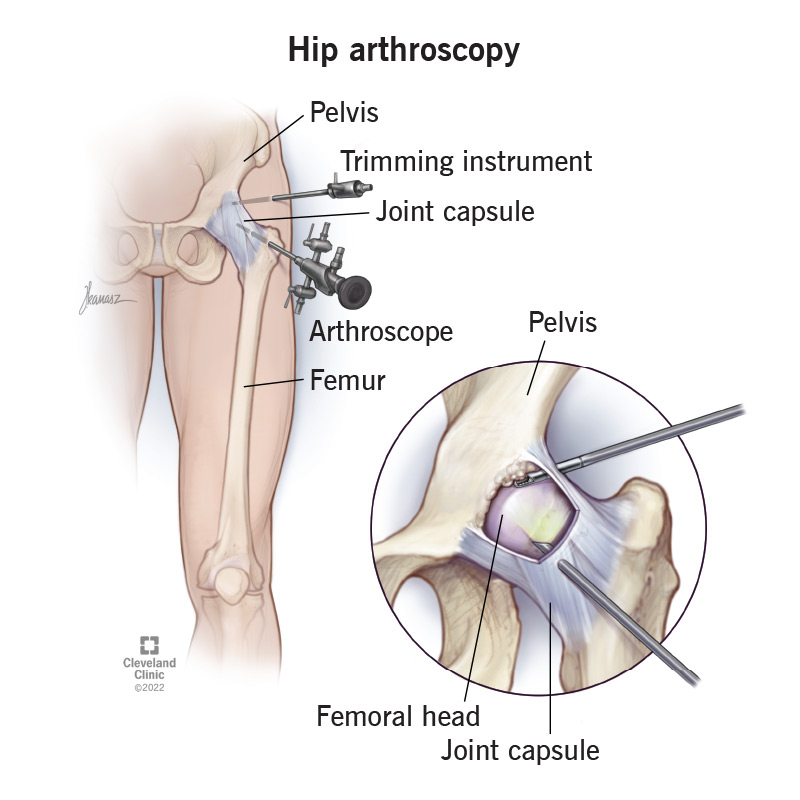Hip arthroscopy is becoming one of the most common ways to treat hip issues, and with good reason: It’s minimally invasive, quick to perform and has a shorter recovery time than many other surgeries.
Advertisement
Cleveland Clinic is a non-profit academic medical center. Advertising on our site helps support our mission. We do not endorse non-Cleveland Clinic products or services. Policy

Hip arthroscopy is a minimally invasive surgery used to treat issues in your hip. Your surgeon will make a few small incisions (cuts) in the skin of your hip then insert a special tool called an arthroscope into your hip joint. The arthroscope includes a camera and a light that lets your surgeon identify and repair damage inside your hip. They’ll also insert any other small tools they need to repair damage to your bones or connective tissues.
Advertisement
Cleveland Clinic is a non-profit academic medical center. Advertising on our site helps support our mission. We do not endorse non-Cleveland Clinic products or services. Policy
The incisions required to perform a hip arthroscopy are much smaller than other forms of surgery, which means it’s less stressful on your body than other procedures. You’ll need physical therapy after your surgery to increase your strength and ability to move your hip again. Most people need a few months to recover after a hip arthroscopy.
Anyone with hip pain that hasn’t responded to other treatments is a good candidate for hip arthroscopy. It can also help people who are having trouble moving properly because of an issue inside their hip joint. Typically, your healthcare provider will recommend arthroscopy only after they’ve identified the cause of your pain and non-surgical treatments like steroid injections or physical therapy and they haven’t completely worked.
Hip arthroscopy is a much less invasive procedure than a total hip replacement (hip arthroplasty). For many people, an arthroscopy will solve the issues causing pain or mobility issues in their hips. If arthroscopy isn’t successful — or if your symptoms are severe enough — your provider might recommend a hip replacement. People with significant damage to their cartilage or severe arthritis usually need total hip replacements.
Advertisement
Hip arthroscopy is an effective, minimally invasive surgery that can treat a wide range of issues.
Some of the most common conditions hip arthroscopy is used to treat include:
Hip arthroscopy is becoming increasingly common, and surgeons are able to treat more conditions than they were even five or 10 years ago.
For years, arthroscopy has been used to treat issues in people’s shoulders, knees and ankles, and it’s quickly becoming more common to address hip issues. Ongoing advancements in technology and surgical techniques have made hip arthroscopy an option for more people than ever before. In fact, some experts estimate that the number of hip arthroscopies performed in the U.S. increased more than 600% in the last 15 years.
Before your hip arthroscopy, you might need to:
Advertisement
During a hip arthroscopy your surgeon will make a few small cuts (about the size of a buttonhole) in the skin on your hip and insert the arthroscope. They’ll also insert any other tools they need to repair any damage to your hip’s bones or connective tissues.
You will receive either regional anesthesia near your hip to make sure you don’t feel pain during the surgery or general anesthesia to put you to sleep during the operation.
Most arthroscopies take around 90 minutes, but the length of your surgery will depend on your unique needs.
Hip arthroscopy is usually an outpatient surgery, meaning you should be able to go home the same day as your procedure. Most people need to wear a brace on their hip for around three weeks after surgery. You’ll need to use crutches for a few weeks, and won’t be able to put any weight on your hip for at least a week.
Your provider or surgeon will give you a personalized recovery plan and will go over the results of your surgery with you.
You may need to:
Advertisement
Hip arthroscopy is much less invasive than other types of surgery. Your surgeon will likely only need a few small incisions to fix the underlying issue(s) in your hip. This means you should experience:
Potential complications from hip arthroscopy include:
Most people recover from a hip arthroscopy in around six weeks. Your exact time to heal fully will depend on why you needed surgery.
You’ll need crutches for a week or two after your surgery. After that, you should be able to walk and put more weight on your hip.
You will also need physical therapy. This could last anywhere from a few weeks to a few months after your surgery. You should be able to return to heavy exercise and/or sports in around 12 weeks.
Talk to your surgeon or healthcare provider for a specific recovery timeline.
Advertisement
If your job or schoolwork involves sitting at a desk or in an office, you should be cleared to return to work or school after a week or two. Check with your provider or surgeon before resuming any activity that might put stress on your hip.
Hip arthroscopy is an increasingly common way surgeons treat a variety of hip conditions. It’s a minimally invasive technique so you can expect a quick surgery, to go home the same day and a relatively quick recovery time.
When your hip pain won’t go away, it’s time to get checked out. Cleveland Clinic hip surgery experts offer the latest in treatment and recovery plans.

Last reviewed on 12/08/2021.
Learn more about the Health Library and our editorial process.